After leaving Omi Island, we headed north along the bridge between Shikoku and Honshu to Inno (een-no) Island. While I don't think it's as well known as Omi Island's Shinto Shrine, Inno Island has a mountain that it is known for the fact that it is covered in stone Buddhas. Inno Island is just north of the border in the sea that separates Ehime and Hiroshima Prefectures, so it's considered part of Hiroshima.
大三島を離れて、西瀬戸橋で因島まで行った。因島はちょっと北の方にあるが、もう広島県に成っている。そこに仏像が沢山集まっている山があるので、それを見に行った。
我們離開大三島、再去因島。因島算是廣島縣一部分、在大三島北方。很多佛像在因島最高的山上。
We got to the end of the car road up the mountain, to the place where you have to start to walk, and were greeted by this positive omen: the Buddha shining in the sunlight.車を降りて、ここから歩き始めた。仏に太陽が当たって、いい予感がした。
這裡下車開始爬山。看到了佛畫的光明、就知道來這裡是正確的選擇。
A bug on the way up.
Here's the first stone Buddha we saw.
一つ目の仏像。
差不多爬到山上了、看到這些佛像。
山の上から見る瀬戸内海は本当に綺麗だ。
On the final steps leading up to the top of the mountain is another small collection of Buddhas.
At this point, we're up at the top of the mountain. There's a flat area with lots of Buddhas, and a small temple, which I'll show you photos of in a bit.
頂上に着いた。仏像が沢山あって、小さなお寺もある。
到了山上!佛像很多!
A tengu. Tengu are sometimes portrayed as big, bird-people, and sometimes as people with very long noses. They're supposed to be excellent swordsmen, and while sometimes they trick people, sometimes they help them too. The idea of them was originally transmitted from China, but they were considered evil at that time. Over time, they became associated with Buddhist protector beings, and so you portrayals of them in temples sometimes.下面三個石像都是「天狗」。本來天狗的概念從中國來、可是後來牠們變成一半鳥、一半人的怪獸。(很奇怪吧。雖然名字有「狗」的漢字、但是不但不是狗、反而是鳥。)到了戰國時代天狗平常算是不好的怪獸、後來從江戶時代開始變成像佛教的守護神那樣子了。
I think this one is a more bird-like tengu.
天狗の石像が三つ境内の入り口にあった。聞いた話では、天狗は元々平安時代に悪い怪物とされたけど、江戸時代に入ってから、いたずらをするイメージが残っているにもかかわらず、だんだん仏教の仲間というイメージが出来た。
And here's another big-nosed tengu.
天狗當中有的比較看起來鳥、有的比較看起來鼻子很高的人。
站在山上欣賞瀨戶內海真的不錯!
There are so many beautiful views of the Seto Inland Sea from up here.
下の写真とその下の写真を説明しよう。この大きな岩はこのお寺の発祥のきっかけだと言われている。昔、ある青年と少女がお互いに好きになって、その男は「力士の修行をする為に江戸に行くけど、三年以内帰ってくる。その時結婚しよう」と約束した。少女はその後三年間待って、男が帰って来なかったので、自殺した。男は5年が経ってから、やっと帰って来た。少女が亡くなったと聞いたら、凄く寂しくて悔しく思った。その夜夢を見て、海辺に行く様に支持されたと悟った。実際に行ってみたら、そこに少女の顔に似ている岩があって、それを山の上まで運んで行った。(さすが力士は力あるね!)それ以来、お寺が出来て、仏像が沢山ここに建たされる様になった。
The photo below shows where the rock is (in the back of the temple on the mountain) and the photo above shows the rock itself. This rock is purported to be the origin of the temple here. There was a young man who fell in love with a woman on the island. He promised that he would come back and marry her in three years after he got his sumo career going. She waited for him, but after three years he still hadn't returned, and she killed herself. The man finally did come back, and when he heard that the woman had died, he was overcome with grief. He then had a dream that told him to go to the seaside. When he did, he saw a large rock that looked like the woman he loved. (This is where the sumo part comes into play. This guy was evidently pretty strong.) He carried(!) this rock up the mountain and put it here. The temple was established after that, and the stone Buddhas everywhere are done in memory to this first stone that was brought up here.
上面兩張的石頭是這座寺廟的原因。有一個故事:很久以前有的男生和女生愛上了。男生想要當力士(做相撲的人)跟女生說「我要離開這裡三年、但是我回來我們就結婚好吧?」女生等他三年、可是他沒回來、所以女生就自殺了。後來男生其實回來聽到女生過世了。他當然很寂寞、很可惜、可是回來了第一天他做夢、認為自己要去海邊。隔天去看看、找到了一頭很大的石頭。那頭看起來女生的臉。男生決定要把石頭搬到山上、就一個人搬到了。後來在山上寺廟是建築的、很多佛像也是設備的。
境内内の仏像を全部回って見たら、必ず一つ、自分の顔に似ているのを見付けると言われている。
Supposedly, everyone who comes up here can find one statue with their face on it.
據說每個人來這裡找得到一個佛像看起來自己的臉。
More fabulous views of the Seto Sea.
この旅で初めて瀬戸内海に来たけど、凄く気に入った。本当に綺麗な所だ。
A bell, which you are free to ring if you wish. (Believe me, you do wish.) It's pretty cool ringing a huge bell on top of a mountain like this.
山の天辺にある鐘を鳴らすのは気持ちいいぞ!
This photo below gives you a pretty good idea of just how many statues are up here.
写真の中に見える立っている石は全て仏像だ。
這片也許是最看得清楚佛像怎麼多。
These two statues were done in color! Oh, wait...
仏像だと勘違いした若いカップル。
這兩個好像不是佛像、、、
A bunch of Buddhas arranged like a lotus flower.
蓮の花になっている仏像の集まり。
這些把集中、做一朵蓮花。
日本に住んでいた時のお気に入りの花、彼岸花だ。九月になると、いきなりあちらこちら咲いて来るので、「秋の桜」と勝手に名前を付けた。(まさかこの発想は俺だけじゃないだろう?)仏教関係の花の一つだから、お寺の雰囲気にとても合っている。
This is one of my favorite flowers in Japan. You can only see it for a couple weeks in fall, around the autumnal solstice. It's called the Higan Flower. During the rest of the year, the plant has a bulb underground (which is poisonous, by the way) but then suddenly in mid-September, these flowers in red, pink, yellow, and white appear all over the place. "Higan" is a name for the two periods of about one week around the two solstices, and it's a Buddhist influenced celebration that developed in Japan, so it's appropriate to see this flower here since the flower has strong Buddhist connotations in Japan.
這些花是石蒜。跟日本的一個佛教節慶(叫彼岸)有關係。雖然很漂亮、可是每年只有差不多兩個禮拜看得到。除了那時候以外都沒有花朵。因為花朵出來的時候平常是九月月中(彼岸的期間)、而日文叫這朵「彼岸花」。
The temple, with a picture of the Nishi Seto Bridge.
お寺としまなみ海道の絵。
寺廟和西瀨戶大橋的畫。
Kannnonn, also spelled, Kwannon, Kannon, and in the case of the camera company, Canon, is a Buddhist God/Goddess who is very important in Japan. In Japan she's usually portrayed as female, but when she was originally introduced to Japan, she was male, and she is occasionally still portrayed that way even now. I don't know if this statue is an example of this or not, but because Kwannon is such a commonly portrayed Buddhist goddess in Japan, during the 17th-19 centuries when Christianity was out-lawed in Japan, many hidden Christians would portray the Mother Mary in such a way that if the statue or painting was ever found, they could plausibly claim that it was a statue/painting of Kwannon.
「観音のローマ字方は気に成った。この方式もたしかあると思う。(つまり「ん」が「nn」になっているという方式。)でもあまり見掛けない。この観音に十字架があるというのはもしかしてこれは隠れ切支丹が使った聖母マリアの石像ってことかなと思った。観音の仏像などが日本にたくさんあるので、江戸時代の隠れキリシタンは時々聖母マリアを作った時、観音に見える様に作って、それでバレても何とか罰を逃すことが出来た。
上面的觀音有一個十字架。沒有看板說這樣子、但是我自己猜也許是一個聖母像。江戶時代日本政府讓基督教不合法了。政府嚴重地處罰了基督教徒也沒關係、還有一些人繼續當基督教徒。為了不會被發現了、他們做聖母像的時候、常常做的是看起來觀音的。
The story of the guy schlepping the huge stone up the mountain is very cool, but realistically, this is how they actually get the rocks up there.力士が自力で岩を山の上まで運ぶという話はめっちゃ格好いいけど、実は仏像をこの蜜柑トラックみたいなやつで運んでいる様だ。
力士的故事沒關係、其實用車把石像搬到山上。
Next, a little more of the Seto Sea!
瀬戸内海の写真まだあるぞ!
下次、還有瀨戶的照片!

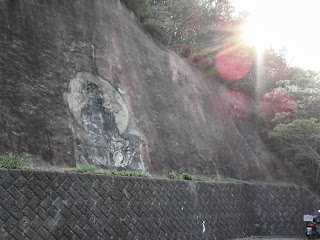




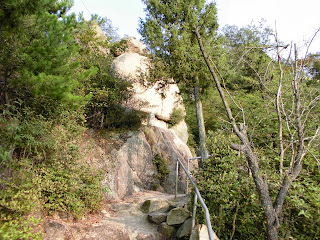

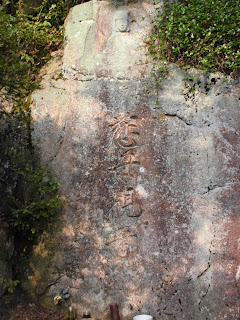


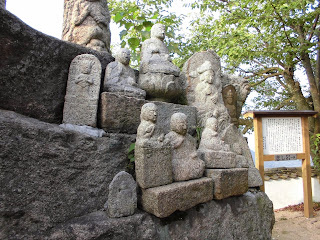



















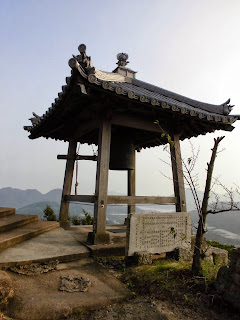



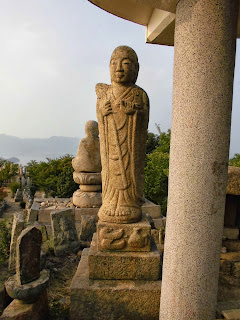







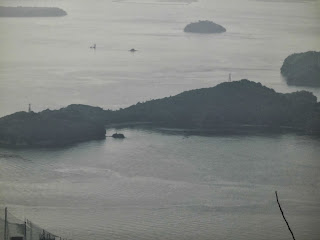






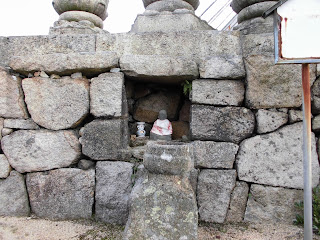













No comments:
Post a Comment